Environmental Issues and Economics in Food Production
1/61
There's no tags or description
Looks like no tags are added yet.
Name | Mastery | Learn | Test | Matching | Spaced |
|---|
No study sessions yet.
62 Terms
What is One Health?
"The collaborative effort of multiple disciplines - working locally, nationally and globally - to attain optimal health for people, animals and the environment"
(AVMA, 2008).
What is the 'One Health' approach?
"Designing and implementing programmes, policies, legislation and research in which multiple sectors work together to achieve optimal public health outcomes"
(WHO, 2017).
Why use a one health approach?
•Applicable to many situations
•Zoonoses are a classic example e.g. Salmonella
How is a one health approach used to control zoonoses? (4)
•Targeted legislation (both animal and human)
•Improving environment (battery cages, rats etc)
•Human behaviour (incentives, penalties)
•Animal health and welfare (vaccination, env enrichment)
Who uses a one health approach? Core and additional examples.
•Core: medics, vets, scientists
•Additional: social scientists, mathematicians, computer scientists, business, government, NGOs and charities, general public etc. depending on level of activity.
What aspects of the environment does livestock production impact? (5)
- Energy consumption i.e. increased demand (fertiliser production, machinery, loss of non-renewables)
- Ecology (biodiversity and loss of species, landscape degradation)
- Air quality
- Soil quality (structure and contamination)
- Water quality (contamination, consumption, flooding)
How does livestock production impact air quality?
Causes in increased production of greenhouse gases (GHGs)
- N2O - due to feedstock production, has a ghg potential
- CO2
- CH4
- NH3
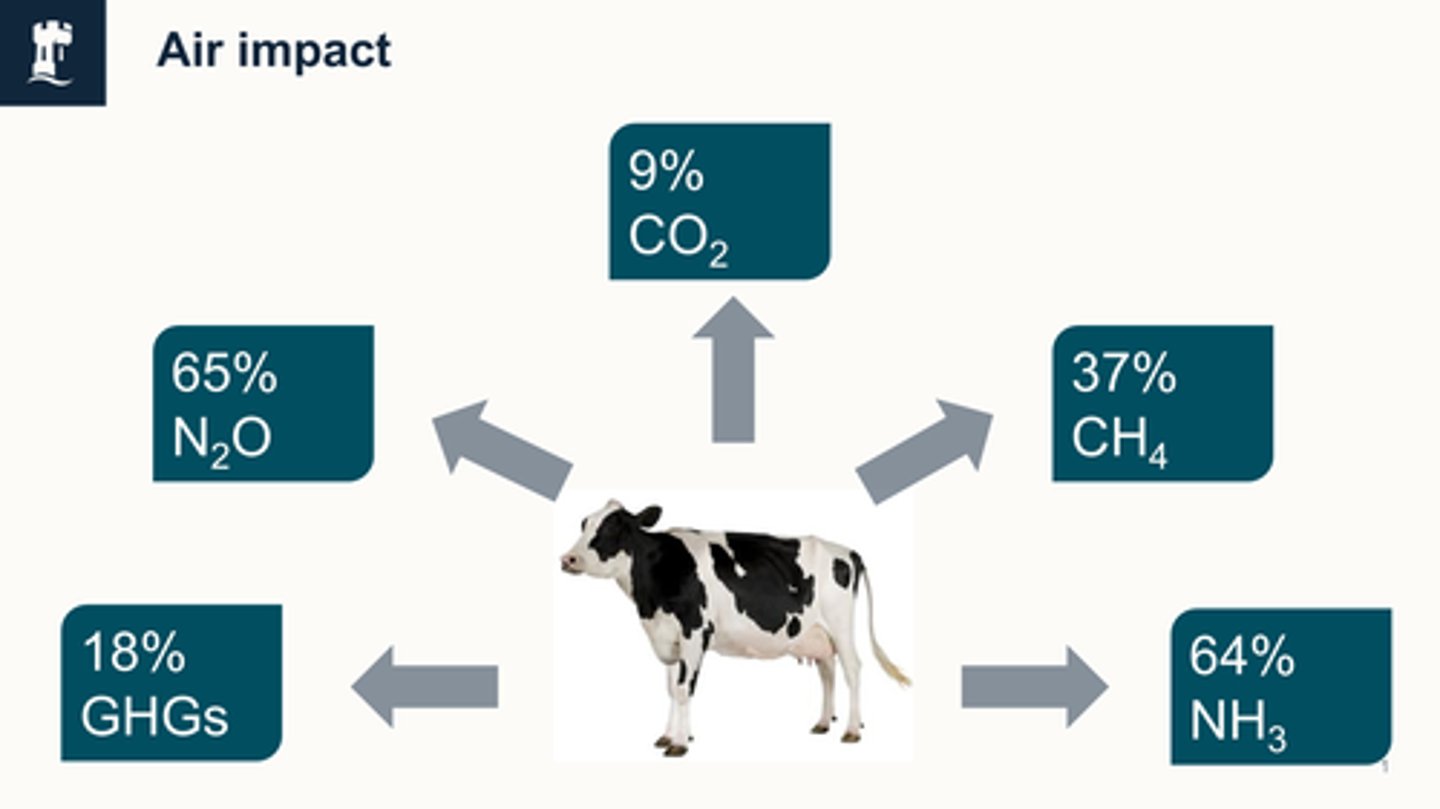
How does livestock production impact soil quality?
- Pollution (4)
- Soil structure (3)
- Ecology (3)
Pollution
Use of agricultural pesticides
Use of veterinary medicines
Heavy metals
Pathogens
(salmonella infantis pESI)
Change in soil structure
Compaction (from walking/living on it)
Increased water run off (from shallower root crops and compaction)
Erosion
feed crops
maize (causes erosions)
Change in ecology
Use of anthelmintics - (affecting invertebrate populations)
Use of antibiotics - (affecting microbial populations)
Compaction reducing ability for invertebrates/microbes to survive
avermectins (can affect invertebrates for mo after theyre applied)
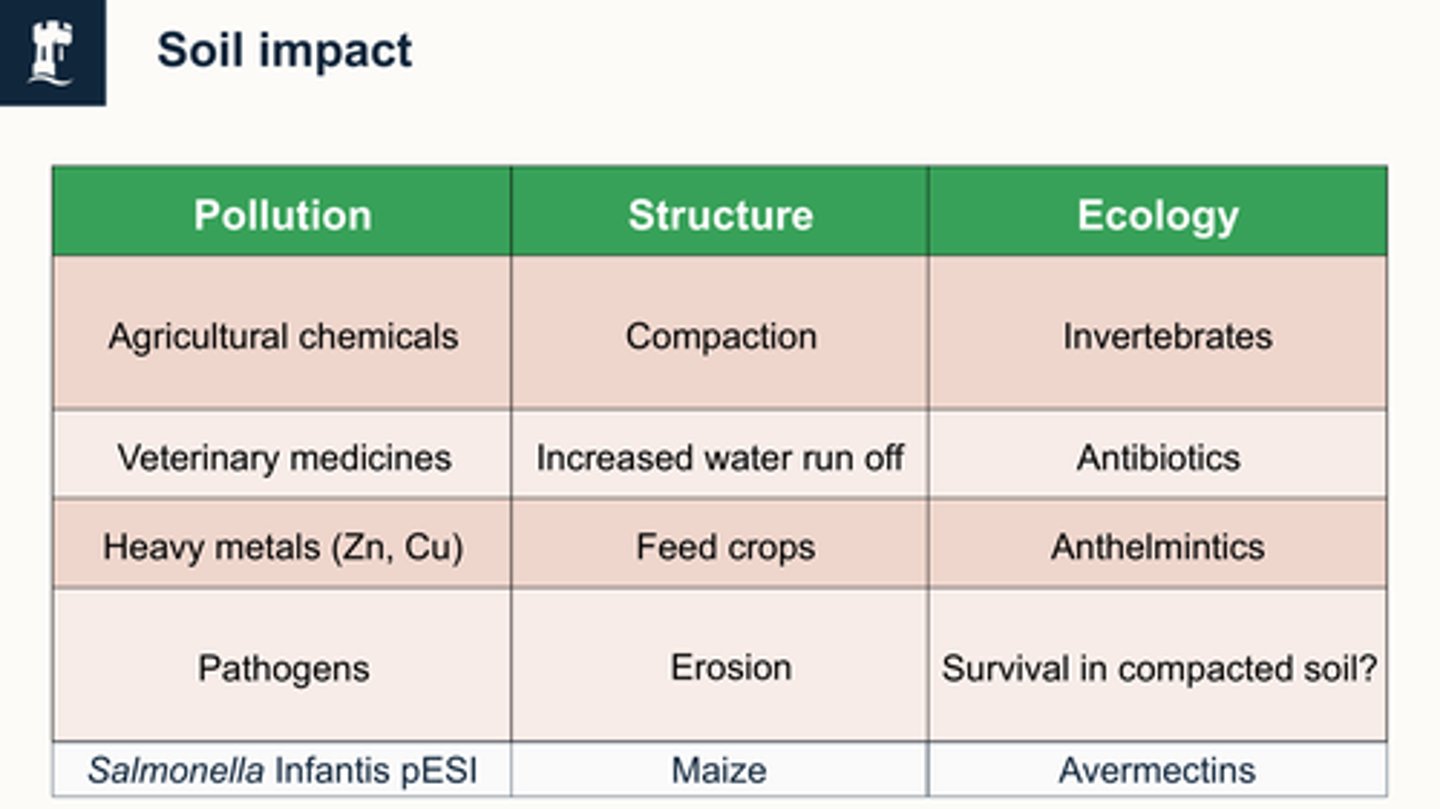
How does livestock production impact water quality? (3)
70% of all fresh water used for agriculture
Little incentive to be efficient (water is often cheap).
Leaching of nitrates and phosphates into fresh water kills fish and organisms via eutrophication
causes the growth of algae → reduces amt of o2 → reduces biodiversity
meat production uses most water
What is eutrophication?
What is the consequence on aquatic bodies?
- Excessive nutrients in a water body causing overgrowth of algae.
- Causes oxygen deprivation in water, suffocating and reducing biodiversity
How is a OneHealth approach applied to eutrophication? (4)
- EU Nitrates Directive / 'Nitrate Vulnerable Zones'
- Farmers need to plan N addition to fields and must not exceed loading limit
- NVZs cover most of central and southern England.
- Limits eutrophication
How does livestock production impact energy consumption? (4)
- Energy consumption for agriculture ~2-3%
- BUT disproportionate production of GHGs (~20%).
- Heavily dependent on fossil fuels (e.g for fertilizer) particularly larger farms
- Energy used for meat >>> plants.
Larger farms more dependent on fossil fuels
How does livestock production impact ecology/biodiversity? (2)
- Humans and wild mammals are relatively small proportion of biomass but have a proportionally larger impact on the environment
- Major decline in biodiversity over past 100 years, due to increased domesticated mammalian species and humans
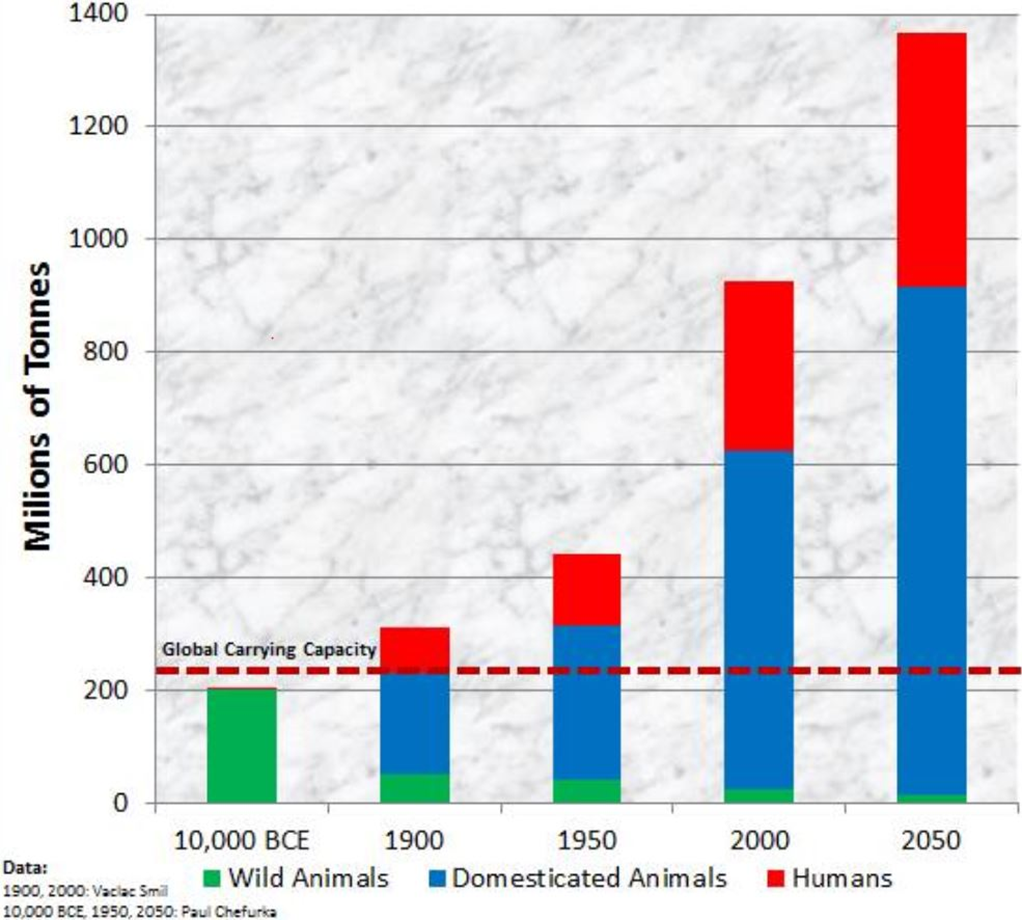
how have humans impacted the biodiversity changes
Land clearance
Pollution
Climate change
Monocultures
Selective breeding in livestock
Soil compaction/erosion
Deliberate policy (e.g. ‘pest’ species)
What are the risks to human and animal health (One Health) from a reduction in biodiversity? (5)
- Reliance on monocultures increases susceptibility to pests and diseases.
- More likely for ecosystems to collapse
- e.g. sea otter eats sea urchins which eat kelp forests - source of biodiversity in ocean
- Fluctuations in feed and food supply
- Extinction of potentially beneficial species
- Encourages emergence of new pathogens (2/3 of emerging are zoonotic)
Rapid change needed if climate change targets are to be met.
Methane responsible for 25% of global warming, 1/3 of this from livestock, mainly ruminants.
How must we evolve current livestock farming practices to ensure we have food in the future?
Modifying existing systems.
Circular system design.
Green Shed Project (SRUC)
Methane mitigation strategies
what is the green shed project
•Capture CH3 from bedding & animals.
•Pipe to CHP engine
•Bedding ► biodigester ► CHP
•Heating (winter) or polytunnels.
•Only used for finishing stage.
•No differences in welfare
essentially capture the gas and recirculate it to make heat for in the winter
give some methane mitigation strategies
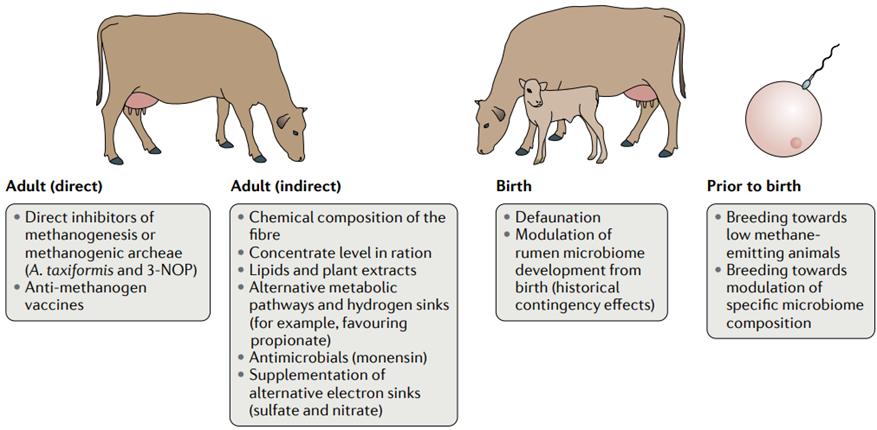
What revolutions have been suggested for current livestock farming practices
- Cultured meat → uses animal ells to grow meat
- Microbial protein → trying to reduce the amt of CO2 produced
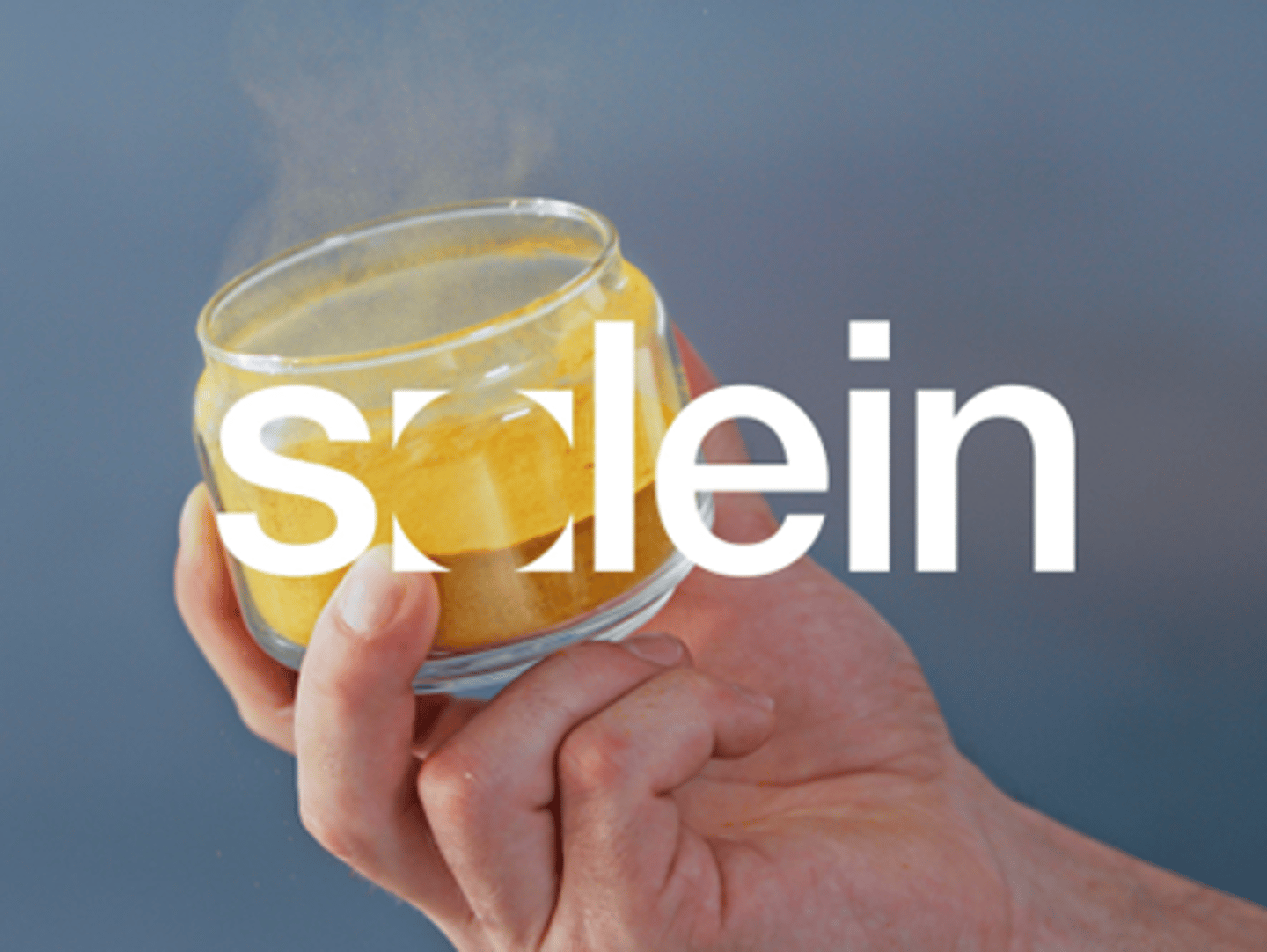
what measures can be used to reduce water usage, what are setbacks of this though
as drip irrigation could reduce water usage,
leaching/pollution and costs, but higher initial capital costs.
How can a One Health approach counteract livestock production impacts on the environment? (3)
What is a limitation to this? (2)
Legislation/protocols to limit the damage
- Legislation: Nitrates Directive.
- Protocol: Drip irrigation to reduce water usage, leaching/pollution and costs
- Requires multi-discipline collaboration
- Can have higher initial capital costs (but long term cheaper)
What is the Green Revolution? (3)
- The development of more productive, drought-tolerant, pest-resistant, higher-yielding crops
- (Resulted in the use of genetic modification, breeding, nutrition and pharmacological drugs to intensify livestock production)
- In 90s
What is the trend of more industrialised farming?
- Fewer, larger farms
What are some consequences to industrialised farming relative to the One Health approach? (6)
Impacts all aspects of One Health approach
Pollution of groundwater
Centralisation and concentration of production
- Physically separates management from workers (accountability, stewardship)
Farm is more vulnerable to animal and human disease outbreaks
Adverse physical, economic, mental and social health in rural communities (from exposure to pollutants)
Poorer welfare of animals - higher stocking density, increased risk of illness and pharmacological treatment
Overwhelms local ecosystem capacity to process waste
How do the impacts of animal waste relate to the One Health approach? (4)
- Poses risk to animal, human and environmental health
- Contains large concentrations of zoonotic pathogen, many become more infectious with storage
- Poultry manure specifically related to Botulism outbreaks (zoonotic)
- Waste must be dealt with/disposed of safely following government guidelines
How can manure be disposed of? (3)
How does it relate to the One Health approach?
All must comply with government regulation
Spread on your own land → May need permit from Environment Agency→ Stop animals grazing on land for 21 days (2 months for pigs)
Process for sale as fertiliser → Need APHA approval → Generally sold as “prill”, dried pellets
Transport and store offsite → to ABP Cat 2 storage facility→ comply with APHA guidance
what litter is botulism most linked with and why?
poultry
- resistant certain types
- low level in poultry
how to manage botulism risk from poultry manure
no bulk feathers/ carcasses/ legs
21 day/ 2 month rule applies
burn manure (APHA permit)
vaccinate against C, D botulinum (not in uk)
Rodent control
despite the botulism risk why is poultry manure liked
bc its cheaper than the increasing artificial fertiliser costs
if a botulism outbreak is linked to your farm what might you haveto show
that you have taken the botulism measurements into account and that you have plans in place
What is the significance of Botulism outbreaks? (2)
- Zoonotic and cause high mortality in cattle and sheep
- Must remove poultry carcasses from litter now
in a crisis what are the two main ways of waste disposal, what are the issues
Burn -> air pollution, spread if not done right
Bury-> Environmental contamination, spread elsewhere underground and into water ect
what aspects can cause issues in a crisis
Scale of the crisis
Disposal methods
Public health
Environmental health
Logistics
What is the impact of emergency large-scale culling and carcass disposal in relation to the 'One Health' approach? (5)
- Emergency/crisis culling to counteract pathogenic outbreak requires disposal of an unexpected large amount of waste
- E.g. FMD outbreak 2001
- Can be done with several methods e.g. Rendering, Incineration, Pyre burning, Composting, Burial / landfill / mounding and Fermentation
- All these methods have significant negative impacts on the environment including energy use, environmental pollution and contamination
- Also significantly impact livelihoods of people/businesses involved in livestock production short term and long-term
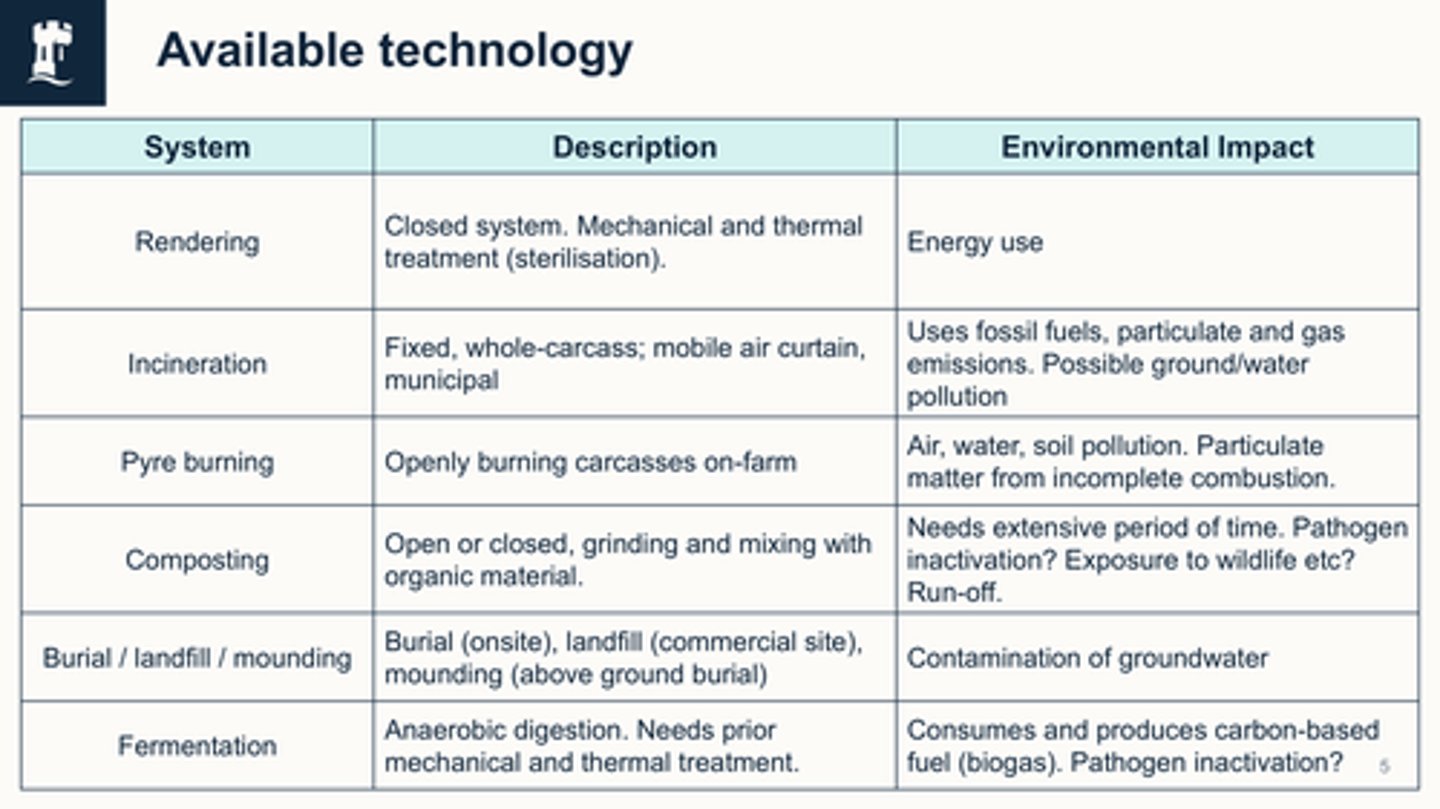
rendering of carcasses, description and env impact
closed system. mechanical and thermal treatment (sterilisation)
energy use
incineration of carcasses, description and env impact
fixed, whole-carcass, mobile air cutain, municiple.
uses fossil fuels, particulate and gas emissions, possible ground water pollution
pyre burning of carcasses, description and env impact
open burning carcasses on farm,
air water, soil pollution, particulate matter from incomplete combustion
incomplete could mean it could still spread
composting of carcasses, description and env impact
open or closed grinding, mixing with organic material.
extensive period of time, pathogen isn't inactivated, exposure to wildlife/ run-off
burial/ landfill/ mounding of carcasses description and env impact
burial (onsite), landfill (commercial) mounding (above ground).
contamination of ground water
fermentation of carcasses description and env impact
anaereobic digestion. needs prior mechanical and thermal treatment.
consumes and produces carbon based fuel (biogas). is the pathogen inactivated?
what were the lessons learnt from the fmd in 2001
Preparedness
Disposal methods
Public health
Environmental health
Logistics
Economics, behaviour and incentives
How has intensive livestock production affected global economics? (4)
Green revolution resulted in:
Increased crop productivity
Globalisation (export of concentrates)
feed concentrates
Intensive production has reduced production costs
Good for middle & high GDP countries
Increased grain costs for animals
Bad for low GDP countries- grain too expensive and major source of human food
Saturated market for meat in developed countries.
Increased demand for meat in developing countries (FAO: the "Livestock Revolution").
what legislation relates to economics and welfare
EU Treaty of Amsterdam (1999)
Animal Welfare Act (2006)
“a life worth living” (minimum), DEFRA
Five Freedoms
Codes of Recommendations for the Welfare of Livestock
How is a One Health approach applied to intensified livestock production from the perspective of a:
- Vet
Vet
- Increased intensity = increased welfare regulations
How is a One Health approach applied to intensified livestock production from the perspective of an economist
Balance
- The cost of welfare as a 'public good' (guilt-free feeling of well raised produce has non-tangible value)
With
- The 'negative externality' (inevitable cost of farming and killing animals - non-tangible)
- Must balance the cost of animal providing welfare with cheaper cost of minimal welfare/suffering
Animal preference irrelevant
Welfare = human preference
‘Public good’, welfare is a feel good factor
Suffering = byproduct
‘Negative externality’
Impact = productivity, consumption
negative externalities in regards to economic perspective
environmental degredation
climate change
public health
ecosystem services
market distortion and inefficiency
mitigating negative externalities in regards to economic perspective
internalise costs
sustainable practice
consumer awareness
what are diff ways we could define welfare
Affective state
Physical fitness and health
Naturalness of living conditions
Bias of stakeholder
How does animal welfare and economics in livestock production relate to a OneHealth approach? (4)
- Higher welfare standards translate to higher productivity, to a point.
- Environment and welfare costs not reflected in price of meat, subsidised by government
- Consumers don't want to pay for improved welfare despite acknowledging its importance
- International trade regulations constrains unilateral action by government
- I.e. governments need to collaborate if they want to increase costs for improved welfare or else they will make themselves vulnerable to losing trade (won't have competitive prices)
defining welfare from a consumer perspective
- affective state
- physical fitness and health
- naturalness of living conditions
depend on the bias of the stakeholder
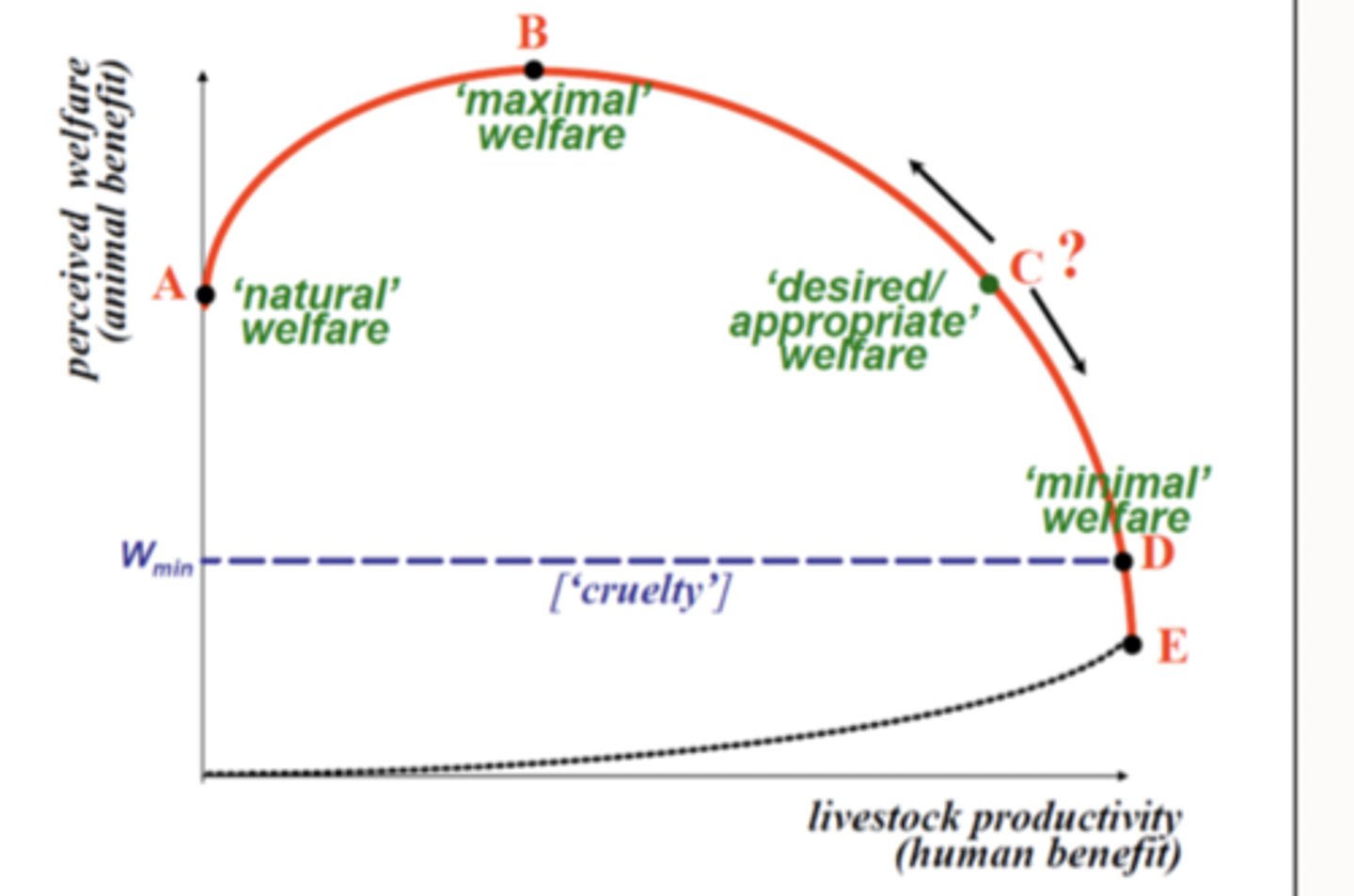
in what ways does natural and maximal welfare contradict
shelter
protection from predators
better nutrition
better housing
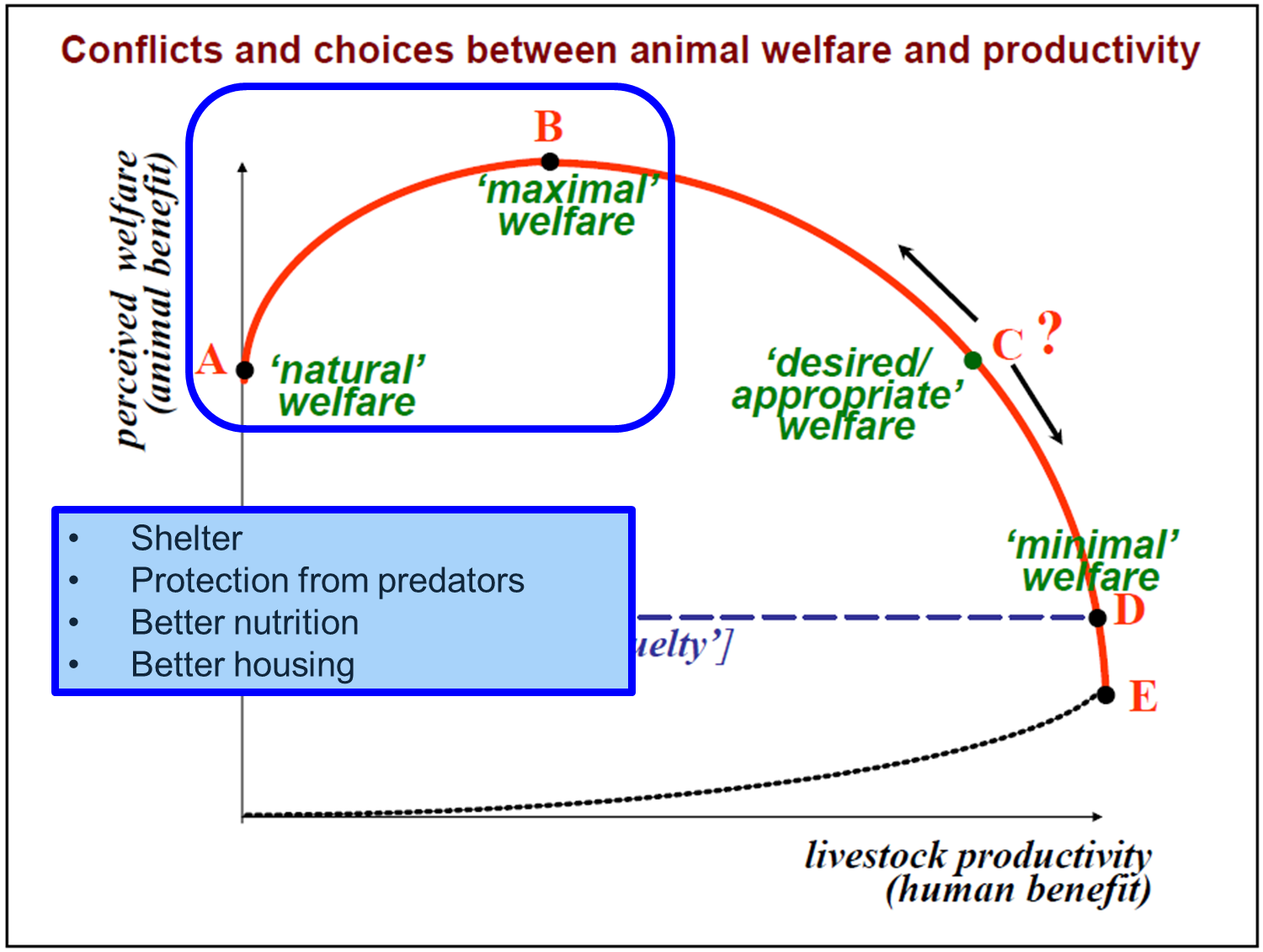
how can maximal welfare and desired welfare with good production vary/ contradict
intensification
pharmaceutical intervention
genetic selection

what may minimal welfare but maximise productivity be explained as
genetic engineering
further intensification
controlled environment and nutrition
growth promoters
gut microbiota manipulation
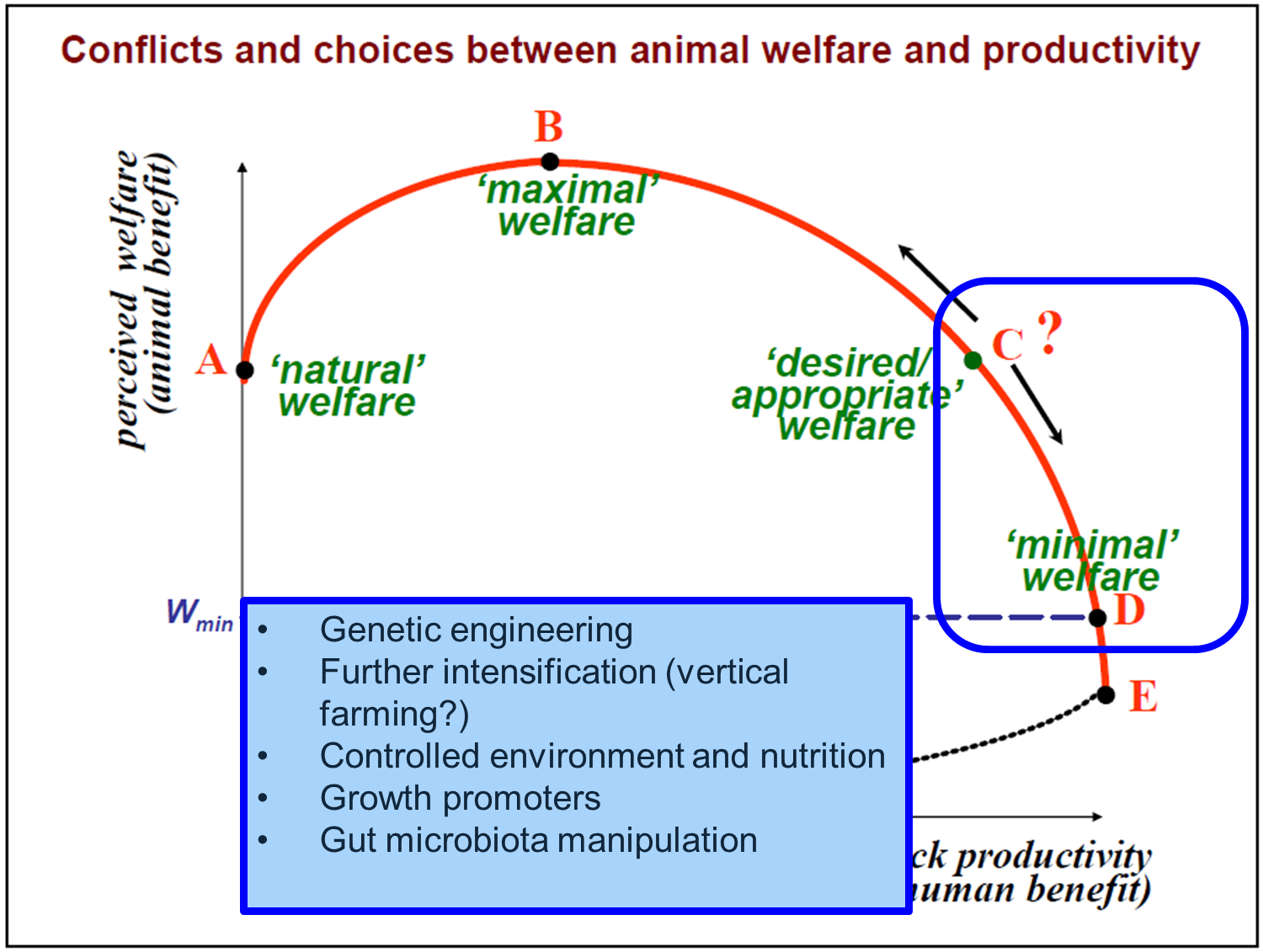
in market centred economics what happens
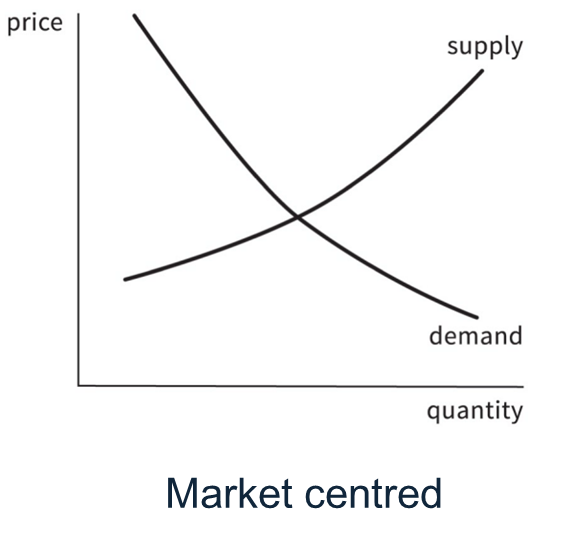
theres supply and demand
cross point is what the price is
in selfish people economics what happens
- Only interested in their own needs and make decisions absed on their own needs
in exponential growth economics what happens
Gdp will always continue to increase
- Will extend into a vertical line -> but cant have infiniate wealth
Sigmoid: what is enough and sustainable
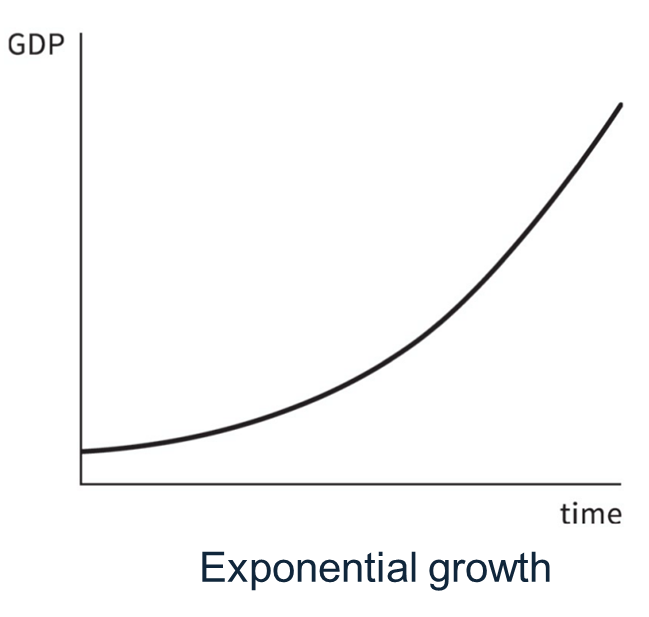
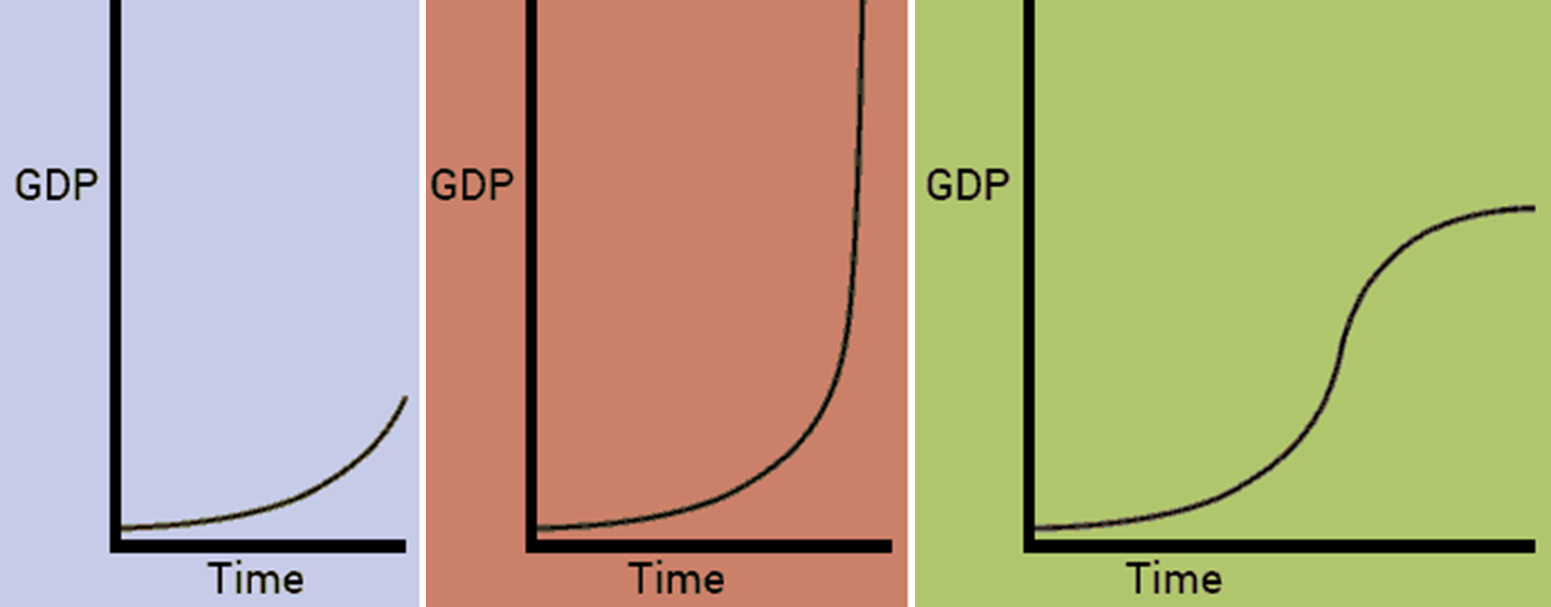
what is donut economy
the centre is reliant on the environment
Ecological measures of sustainablity
Social measures of sustainability
Need the support of society to make these necessary changes
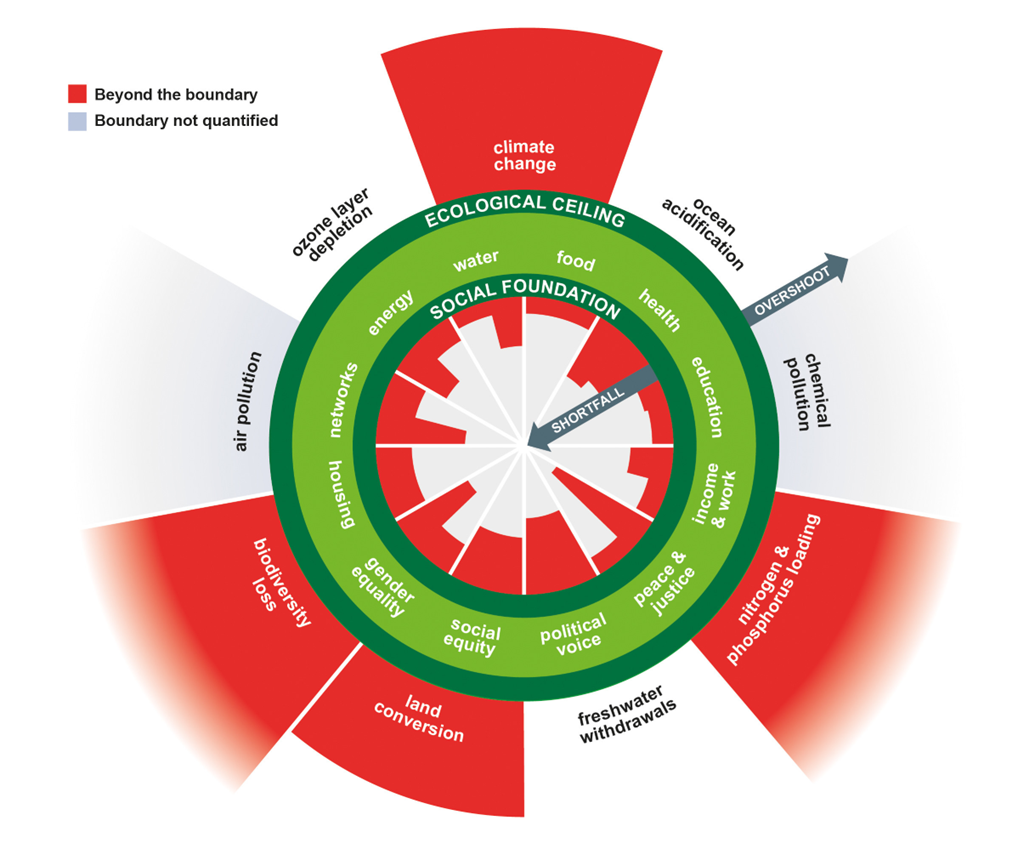
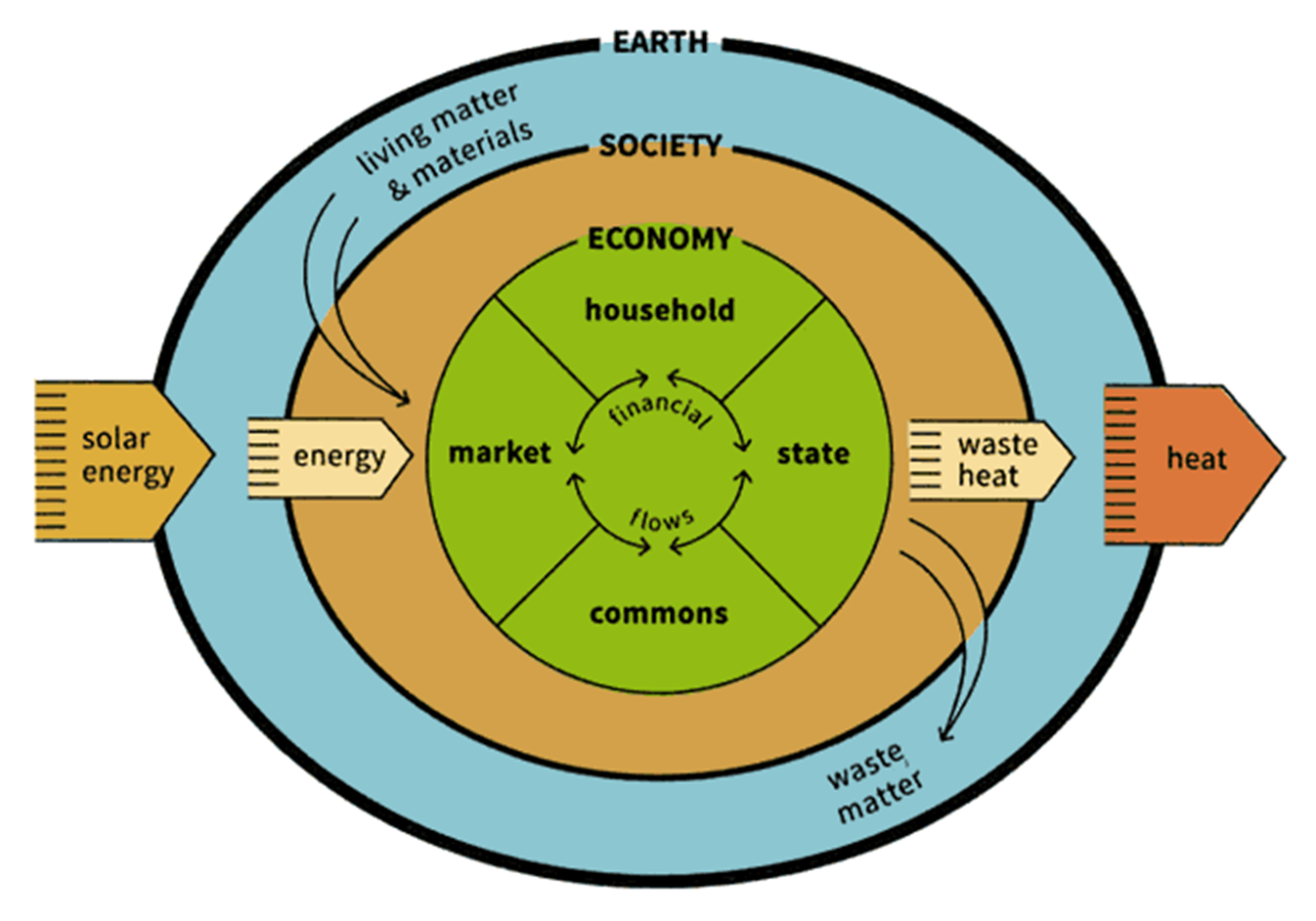
by incorporating the donut economics into animal welfare what changes could be made
Purpose & ownership
Sustainability incorporates welfare
Tax food waste
Reduce variety
Urban agriculture
Reduce/scrap subsidies
Realistic pricing
why might governments need to help farms to maximise welfare which in turn affects and improves other areas
it can be expensive
eg, netherlands broilers
Increasing the welfare meant that they used less antibiotics
But farmers cant afford to do this by themselves -> governments will eneed to help
what does globalisation do
Globalisation decouples productivity from local resources.
how does welfare affect prodcutivity
Higher welfare = higher productivity*
what are some negative extemities of welfare and economics
Consumers don’t want to pay
How do you assign costs?
WTO constrains nations